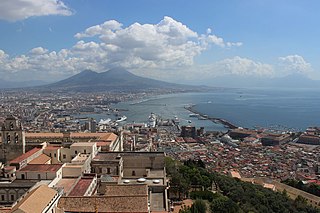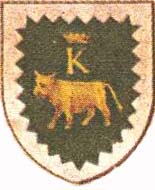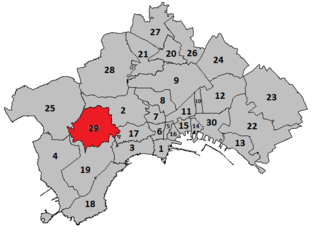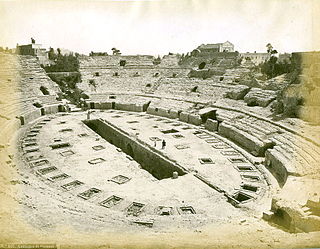
Naples is the regional capital of Campania and the third-largest city of Italy, after Rome and Milan, with a population of 909,048 within the city's administrative limits as of 2022. Its province-level municipality is the third-most populous metropolitan city in Italy with a population of 3,115,320 residents, and its metropolitan area stretches beyond the boundaries of the city wall for approximately 30 kilometres. Naples plays also a key international role in international diplomacy, since it is home to NATO's Allied Joint Force Command Naples and of the Parliamentary Assembly of the Mediterranean.

Salerno is an ancient city and comune (municipality) in Campania, southwestern Italy, and is the capital of the namesake province, being the second largest city in the region by number of inhabitants, after Naples. It is located on the Gulf of Salerno on the Tyrrhenian Sea. In recent history the city hosted Victor Emmanuel III, the King of Italy, who moved from Rome in 1943 after Italy negotiated a peace with the Allies in World War II, making Salerno the capital of the "Government of the South" and therefore provisional government seat for six months. Some of the Allied landings during Operation Avalanche occurred near Salerno.

Trevi is the 2nd rione of Rome, Italy, identified by the initials R. II, located in Municipio I. The origin of its name is not clear, but the most accepted theory is that it comes from the Latin trivium, because there were three streets all leading to the current Piazza dei Crociferi, a square next to the modern Trevi square. Its coat of arms is made of three swords on a red background.

The House of Bove is an ancient noble patrician family of Ravello, Maritime Republic of Amalfi that held royal appointments in the Kingdom of Naples, and presided over feudal territories. After the dissolution of noble seats of the Kingdom of Naples in 1800 they were ascribed in the Libro d'Oro of Ravello. The Bove coat of arms is prominently displayed in the Duomo of Ravello.

Vomero is a bustling hilltop district of metropolitan Naples, Italy — comprising approximately two square kilometres (0.77 sq mi) and a population of 48,000.

The University of Naples Federico II is a public research university in Naples, Campania, Italy. Established in 1224 and named after its founder, Frederick II, it is the oldest public, secular, non-sectarian or state-funded university in the world, and one of the world's ten oldest universities in continuous operation.
Villaricca, known until 17 May 1871 as Panicocoli, is a comune (municipality) in the Metropolitan City of Naples in the Italian region of Campania, located about 10 km northwest of Naples.

San Gennaro dei Poveri is a former monastery and church complex, later converted into a hospital for indigent located on Via San Gennaro dei Poveri #25 in the Rione Sanità, of the city of Naples, Italy. The elongated complex rises towards Capodimonte, lying just south of the domed Basilica dell'Incoronata Madre del Buon Consiglio.

Soccavo is a western quarter of Naples, with a population of about 45,000.
Barra is an eastern quarter of Naples, southern Italy, with a population of some 40,000 inhabitants

Miano is a suburb of Naples, Italy, with a population of around 26,000.

The Flavian Amphitheater, located in Pozzuoli, is the third-largest Roman amphitheater in Italy. Only the Roman Colosseum and the Amphitheatre of Capua are larger. It was likely built by the same architects who previously constructed the Roman Colosseum. The name "Flavian Amphitheater" is primarily associated with the Roman Colosseum.

The districts of Naples are the sectors that, within the city, are identified by particular geographical and topographical, functional and historical features.

The Ninth Municipality is one of the ten boroughs in which the Italian city of Naples is divided.

The Palazzo delle Poste is located in Piazza Matteotti in central Naples. It is an example of architecture completed during the fascist government of Benito Mussolini. Another such example is the nearby Palazzo della Casa del Mutilato and the adjacent Palazzo della Questura on via Medina. Just north and across the street on via Monteoliveto is the 16th-century Palazzo Orsini di Gravina.

The Palace of the Bank of Italy is a twentieth century monumental building in central Naples, Italy located in Via Cervantes.

Via dei Coronari is a street in the historic center of Rome. The road, flanked by buildings mostly erected in the 15th and the 16th century, belongs entirely to the rione Ponte and is one of the most picturesque roads of the old city, having maintained the character of an Italian Renaissance street.

The Colli Aminei are an area of Naples, Italy, that is part of the municipality of Stella-San Carlo at the Arena, specifically of the Stella district. It is bordered to the west and north by the Vallone di San Rocco, to the east by the Capodimonte ascent, to the south by the valleys of the Scudillo and the Fontanelle.
The Rinaldi clan is a Camorra clan operating in the area of San Giovanni a Teduccio, in the eastern area of the city of Naples. Since 2019 the clan has formed an alliance with the Ponticelli's De Luca Bossa clan, and Barra's Aprea-Cuccaro clan, called by the media Rinaldi-De Luca Bossa-Aprea, which has emerged as the most powerful Camorra group in the eastern region of Naples.
Salvatore Pica was an Italian art and design entrepreneur. He was one of the first to promote design and contemporary art culture in post-war southern Italy.
















